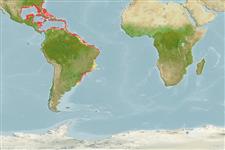Classification / Names
Common names from other countries
Main reference
Size / Weight / Age
Max length : 79.0 cm TL male/unsexed; (Ref. 40637); common length : 50.0 cm TL male/unsexed; (Ref. 5217); max. published weight: 7.1 kg (Ref. 40637)
Length at first maturity
Lm 30.5, range 30 - ? cm
Environment
Marine; reef-associated; depth range 20 - 60 m (Ref. 5217)
Climate / Range
Tropical, preferred ?; 33°N - 33°S, 99°W - 30°W
Distribution
Short description
Dorsal
spines
(total): 12;
Dorsal
soft rays
(total): 15-17;
Anal
spines: 3;
Anal
soft rays: 7 - 8. Scale rows immediately below lateral line oblique (Ref. 26938). Usual color phase dull silvery, the fins largely gray; no black pigment below upper margin of preopercle; the dorsal and caudal fins of subadults and the back above a line from dorsal base to lower margin of caudal fin are often blackish (Ref. 13442).
IUCN Red List Status (Ref. 115185)
Threat to humans
Reports of ciguatera poisoning (Ref. 30303)
Human uses
Fisheries: commercial; gamefish: yes; aquarium: public aquariums
More information
ReferencesAquacultureAquaculture profileStrainsGeneticsAllele frequenciesHeritabilityDiseasesProcessingMass conversion
Tools
Special reports
Download XML
Internet sources
Estimates of some properties based on models
Phylogenetic diversity index
PD50 = 0.5000 many relatives (e.g. carps) 0.5 - 2.0 few relatives (e.g. lungfishes)
Trophic Level
3.3 ±0.1 se; Based on diet studies.
Resilience
Medium, minimum population doubling time 1.4 - 4.4 years (K=0.19-0.20; tm=3.5; Fec=800,000)
Vulnerability
Moderate vulnerability (45 of 100)
Price category
